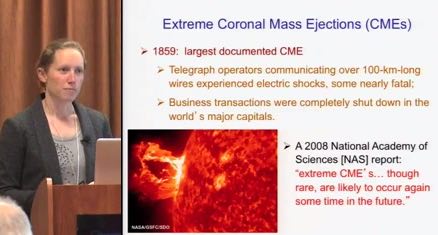In this video from the NCSA Blue Waters Symposium: Jamesina Simpson from the University of Utah presents: Petascale Computing – Calculating the Impact of a Geomagnetic Storm on Electric Power Grids.
The historical record indicates the possibility of future extreme geomagnetic storms on Earth resulting from coronal mass ejections from the sun. These geomagnetic storms can create intense electromagnetic fields at the Earth’s surface that can disrupt electric power grid operations and even cause blackouts. Recent measurements indicate that the storm-time ionospheric currents leading to the disturbed surface electromagnetic fields are not simply amplified versions of quiet-time conditions. Further, electric power grids in varying locations are impacted differently by geomagnetic storms (e.g. “ocean effects,” etc.). As such, the highly complex 3-D ionospheric currents as well as the Earth’s topography and lithosphere content must be accounted for in any study and realistic calculation of storm-time surface electromagnetic fields. Using Blue Waters, we are for the first time running highly detailed, global simulations of the Earth-ionosphere waveguide under the effect of a geomagnetic storm. Disturbed ionospheric currents are modeled in a three-dimensional Maxwell’s equations finite-difference time-domain (FDTD) model extending from -400 km to an altitude of 400 km. Electromagnetic wave propagation and diffusion is calculated on a global scale, and the surface electromagnetic fields are studied in different locations and at different time scales of geomagnetic storms.
Located in Sun River, Oregon, the third annual NCSA Blue Waters Symposium brought together leaders in petascale computational science and engineering. Along with presentations from the Blue Waters science teams, the symposium featured keynotes from innovative thinkers in science and provided opportunities to share and discuss specific topics of interest.




